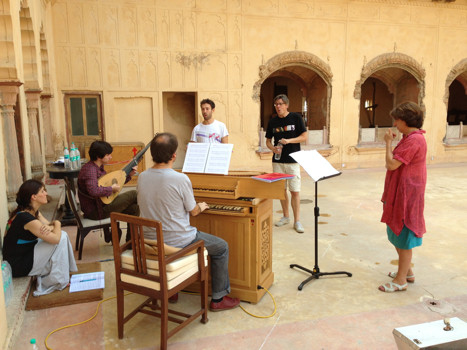Technical Library
CONTINUO ORGAN V: Instant Claviorganum
Entire Contents Copyright © 2023 CBH
Technical LibraryCONTINUO ORGAN V: Instant Claviorganum Entire Contents Copyright © 2023 CBH |
 CAREY BEEBE |
| Harpsichord on top of Klop continuo organ at Carmel Bach Festival |
Stacking the keyboards…
There’s much appeal in pitting the attack of plucked strings against sustained organ tone. Such a combination instrument is called a claviorganum. It’s wonderful when in tune. The claviorganum probably went out of fashion because any musician familiar with both strings and winds knows that disparate instruments head in opposite directions pitch-wise when the temperature changes.
In the absence of a dedicated claviorganum—which may also enjoy the possibility of coupling organ and harpsichord together so they can be played from a single keyboard—you can simply stack a harpsichord on top of the continuo organ to save space and allow a single player to control both, or a conductor to direct his ensemble without having to pivot from instrument to instrument.
It was October 2002 when I first put a Grimaldi harpsichord on top of a Klop continuo organ for a concert given by Il Seminario Musicale directed by countertenor Gérard Lesne on the steeply-raked stage of Dijon Grand Theatre.
It’s become something we now do yearly at the Carmel Bach Festival for when Michael Beattie directs the Adams Masterclass Showcase concert. The photo at the right shows Kevin Fryer’s copy of the 1638 Ruckers on top of the Klop organ from San Francisco Bach Choir, on stage at the Sunset Center Theater in Carmel-by-the-sea.
Some preparation is required: The usual trestle or table stand of a northern European harpsichord obviously can’t be used for this purpose. A support is needed to ensure the weight of the harpsichord is bearing on the organ case, rather than on the music desk. This can be a saddle which rides over the back of the organ case. The tail of the harpsichord needs a tall pod. An Italian harpsichord is easier here, because the usual Italian rear leg can be used on top of a wooden box of appropriate height.
The organ must be tuned first, before the harpsichord is carefully placed on top with keyboards of both instruments aligned at middle c'. As noted on the Tuning page in this section of the Technical Library, closing the top flap of the Klop does change the air flow and affect the intonation. If you are particular and have sufficient time—a rarity before a concert!— you could close the flap to check intonation after each pipe is tuned, and make any necessary adjustments before proceeding to the next note, but this is incredibly tedious. With the help of another person to hold notes, you could tune through the treble side panel or back panel, replacing it frequently to check, because again removing a panel affects the intonation. In many stage layouts, the back panel could well be left off for the performance without being visible to the audience. In any instance I usually tune the organ slightly flat because I know it will rise in pitch.
 CAREY BEEBE |
| Pentagonal virginal on top of Klop continuo organ for Orfeo, crossing the Ganges Claire Lefilliâtre, Thomas Dunford, Laurent Stewart, Johannes Weiss, Jan Van Elsacker & Françoise Lasserre |
| Continuo Organ for hire | |
| Your own Continuo Organ | |
| Technical Library overview | |
| Harpsichords Australia Home Page |